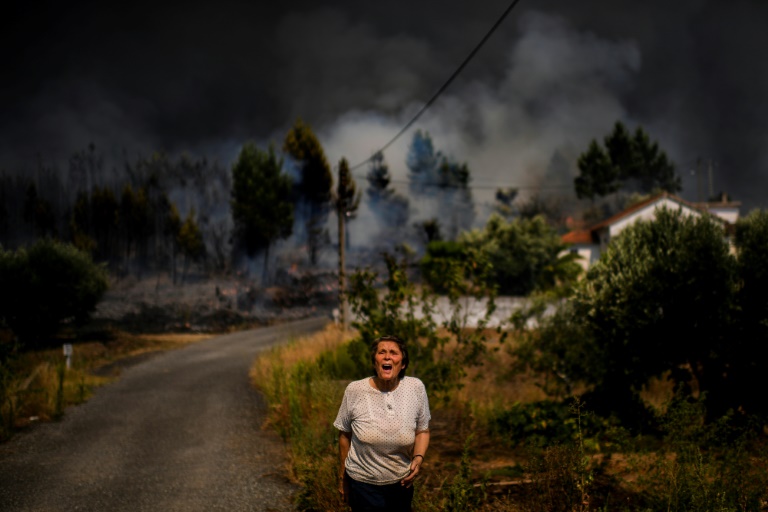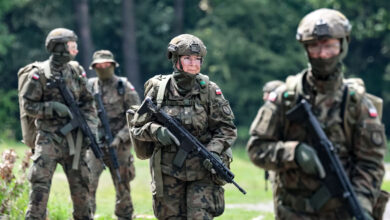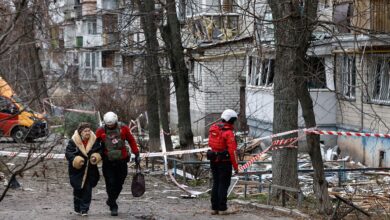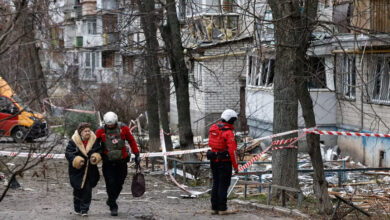
Portugal requested the loan of two water-bombing planes on Monday as winds revived massive wildfires in a central region where dozens of people were killed in huge blazes in 2017.
Portugal’s civil protection agency had said on Monday morning the wildfires were “90 percent controlled” but officials said they were fanned back into life when winds picked up in the afternoon.
Later in the evening, officials said they were making some progress against the blazes again but that it was slow work.
“During the morning it was practically controlled but weather conditions did not allow a consolidation of the situation,” Prime Minister Antonio Costa told journalists.
In response to a demand from Lisbon, Spain sent two heavy amphibious aircraft to help fight the blazes which broke out on Saturday amid scorching temperatures, the interior ministry said.
Nearly 1,300 firefighters backed by 17 water-dropping aircraft were deployed to fight the blazes in the heavily forested Castelo Branco region, 200 kilometres (120 miles) northeast of the capital Lisbon.
Thirty-nine people have been injured since the wildfires broke out on Saturday, including several firefighters who were hurt on Monday, the civil protection agency said.
Most suffered smoke inhalation but a civilian was evacuated to a Lisbon hospital with serious burns.
As night fell, Portugal’s civil protection agency commander Pedro Nunes said the flames were “losing intensity” and the situation seemed to be “evolving favourably” once again.
‘Can’t believe it’
Exhausted firefighters poured water over their heads to cool off as temperatures neared 40 degrees Celsius (104 Fahrenheit).
 AFP / PATRICIA DE MELO MOREIRA Authorities are looking into whether the fires may have been started deliberately
AFP / PATRICIA DE MELO MOREIRA Authorities are looking into whether the fires may have been started deliberately“Yesterday we thought we were done, it was completely extinguished, then suddenly the fire resumes with this wind, we can’t believe it,” Fernando Almeida told AFP in the village of Casais de Sao Bento as he filled a huge tank in his garden which a helicopter used to pick up water to fight the blaze.
While a number of small villages were evacuated over the weekend as a precaution, Nunes said no built up areas were now at risk.
Authorities are looking into whether the fires may have been started deliberately as several blazes broke out at roughly the same time near each other, Interior Minister Eduardo Cabrita said Sunday.
Police said a 55-year-old man had been arrested in Castelo Branco suspected of setting a fire on the outskirts of the town, though this one was far from the main infernos.
Seven regions of Portugal were on fire alert on Monday because of the dry weather and high temperatures.
‘Strong cocktail’
The centre of Portugal is hilly and covered in dense forest and is regularly ravaged by fires, including the deadliest in the country’s history when 114 people died in two separate blazes in June and October 2017.
 AFP / Paz PIZARRO The mayor of Vila de Rei in the Castelo Branco region said “unfortunately terror returned once again”
AFP / Paz PIZARRO The mayor of Vila de Rei in the Castelo Branco region said “unfortunately terror returned once again”Much of the population in the area is elderly, as young people move to the cities.
The forests are largely eucalyptus, a highly flammable wood used in the paper industry.
Despite the combustion risks, the trees are planted because they are fast-growing and a major source of income for locals.
With fields and pastures abandoned, the forests are poorly maintained, and the dense undergrowth facilitates the spread of the fires.
Climate change has become another factor, bringing hotter, drier and longer summers, said Nunes, the civil protection agency commander. The peak fire season, which used to run from July to September, now starts in June and ends in October.
This, combined with the huge amount of “combustible material” in the country’s forests, has created a “very strong cocktail to generate wildfires with enormous releases of energy”, he said.
According to the EU’s European Forest Fire Information System, more than 250,000 hectares (620,000 acres) of land was destroyed by fire across Europe between January and April this year, compared with 181,000 hectares recorded for the entire fire season in 2018.




